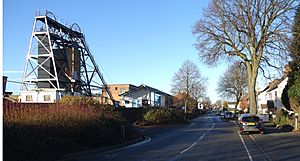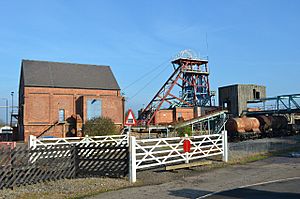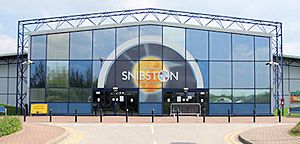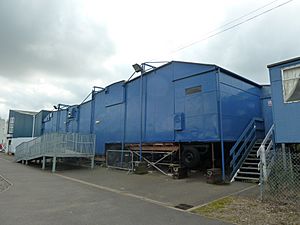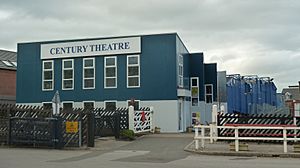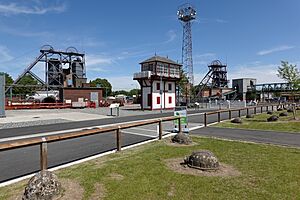Snibston facts for kids
Quick facts for kids Snibston |
|
|---|---|
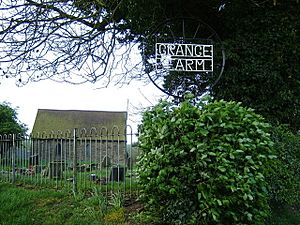 St Mary's church, Snibston, in Hugglescote and Donington le Heath |
|
| Civil parish |
|
| District |
|
| Shire county | |
| Region | |
| Country | England |
| Sovereign state | United Kingdom |
| EU Parliament | East Midlands |
Snibston is an area in Leicestershire, England. It's located east of Ravenstone and is now part of the Ravenstone with Snibstone area.
Snibston used to be a quiet countryside area. But in the 1830s, it changed a lot when coal mines opened here. This turned part of Snibston into a busy coal mining village. Over time, this industrial part became part of the nearby town of Coalville.
Even today, you can still find rural parts of Snibston. In one of these areas, there's a very old church called St Mary's. It was built in the 1200s and is known as the smallest church in England still used for regular services!
The main coal mine, called Snibston Colliery, started in 1831. After it closed, a fun place called Snibston Country Park was built on some of the old mine land. It used to have the Snibston Discovery Museum, which is now closed. Part of the park is also a special place for nature called Snibston Grange Local Nature Reserve.
Contents
Snibston's Mining History
The famous railway engineers, George Stephenson and his son Robert Stephenson, came to Snibston in the late 1820s. They were working on the Leicester and Swannington Railway. This railway was built to carry coal from this area to the city of Leicester.
The Stephensons quickly saw that there was a lot of coal here. So, in 1831, they started digging deep holes, called shafts, to reach the coal. This was on the north side of the railway, near where Coalville is today. This first mine was called Snibston Colliery No. 1. It had some challenges, like lots of water and hard rock, so it wasn't their easiest project.
Another coal mine, Snibston Colliery No. 2, was built on land owned by Leonard Fosbrooke. After he passed away, the Stephensons bought the land. They finished building the mine and even built cottages for the miners to live in. This is the mine that became known simply as Snibston Colliery, and it's the one you can still see parts of today.
In the 1800s, Snibston was described as a small village, or 'hamlet'. It had about 595 people living in 110 houses. Coal mining was a very important job here.
The Snibston collieries (mines) were two of the three main coal mines that helped create the town of Coalville. Today, most of Snibston is part of Coalville. But you can still spot the old buildings and tall structures (called headstocks) of Snibston Colliery No. 2. This area is also part of The National Forest.
A third mine, Snibston Colliery No. 3, opened in 1850 but closed in 1895.
Snibston Colliery No. 2 produced coal for a very long time, from 1833 to 1983. Many of its old mining buildings are now very rare. The government has protected them as important historical sites. When the mine finally closed in 1985, the local council bought the land. They wanted to save the important buildings and turn the rest of the old mine site into a fun park and a new museum.
The railway line that connected Snibston Colliery to the main railway was built by Robert Stephenson between 1833 and 1836. It was only for carrying coal, not people. After the mine closed, parts of the railway were taken apart. But a section of the line near Coalville was rebuilt between 1998 and 2001.
Snibston Discovery Museum
The Snibston Discovery Museum was once a popular attraction. It was built on part of the old Snibston Colliery No. 2 site. It was an exciting, hands-on museum. Next to it were the old mine buildings, the Century Theatre, and a large country park with a nature reserve. This whole area is within The National Forest.
The museum had many interactive exhibits. You could even take a tour of the colliery, ride a train, and explore a fashion gallery. The museum taught visitors about technology and design and how they affect our daily lives.
Museum Closure
In 2015, the local council decided to close the museum. It cost a lot of money to run each year, and fewer people were visiting. The museum closed on July 31, 2015. The main museum building was taken down in 2016.
However, the old Snibston Colliery buildings and headstocks are still there and protected. The Snibston Country Park is also still open for everyone to enjoy.
Century Theatre
The Century Theatre is a very special building. It's a portable theatre, meaning it can be moved! It was built in 1952 on a series of old RAF trailers. It was designed to be a professional theatre that could be folded up and moved by road.
After it first opened in 1952, the theatre traveled all around Britain until 1974. It would stay in each town for only a few weeks. From 1974 to 1997, it was used as the town theatre in Keswick.
Later, it was saved from being scrapped and brought back to Leicestershire. It's now located next to the old Snibston Colliery buildings. The theatre was created to bring high-quality plays to communities across Britain after World War II. Many actors and technicians who worked with the Century Theatre went on to become very important in the world of theatre.
In 1996, the theatre was brought to Snibston Discovery Museum. It was carefully taken apart and then put back together on a special site between the museum and the historic mine buildings. It reopened in 1997. Since then, it has been a place for many different arts events, including plays, music, and dance. A new front section was added in 2011, making it even better with a lounge, toilets, and easy access for everyone.
Snibston Colliery Park
Snibston Colliery Park opened in late 2020. You can now visit parts of the old Snibston Colliery site again. There's a new footpath along the old railway line that went into the mine. There's also a new cafe and a car park. You can follow a heritage trail to learn about the area's history. The park also includes the nearby nature reserve.
Since April 2022, you can even take guided tours of the old colliery buildings again! These tours are run by the Snibston Heritage Trust and the local council.


